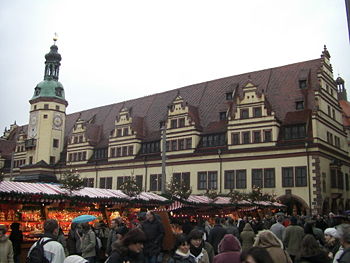Revision as of 11:05, 15 April 2009 by imported>Hayford Peirce

PD Image The old
townhall in
Leipzig. The tower is positioned between the left (a) and right (b) sections so that

equals the golden ratio.
The golden ratio, also frequently known by a number of other names such as golden section or golden mean, is a mathematical proportion that is important in the arts and interesting to mathematicians. In architecture and painting, some works have been proportioned to approximate the golden ratio ever since antiquity, when, supposedly, some of the buildings on the Acropolis derived their eye-pleasing esthetics from the use of this ratio in determining the length of the buildings to their height and width.
According to the Merriam-Webster's Collegiate Dictionary, Eleventh Edition, the proportion is derived from two segments in which "the ratio of the whole to the larger part is the same as the ratio of the larger part to the smaller."
To be more elaborate: if there is a longer line segment  and and a shorter line segment
and and a shorter line segment  , and if the ratio between
, and if the ratio between  and
and  is equal to the ratio between the line segment
is equal to the ratio between the line segment  and
and  , this ratio is the golden ratio. The value of the golden ratio is
, this ratio is the golden ratio. The value of the golden ratio is 
Properties
- If
 it follows that
it follows that 
With  we could derive the infinite continued fraction of the golden ratio:
we could derive the infinite continued fraction of the golden ratio:

Thus

 ,
,
where  is the n-th term of the Fibonacci sequence.
is the n-th term of the Fibonacci sequence.












